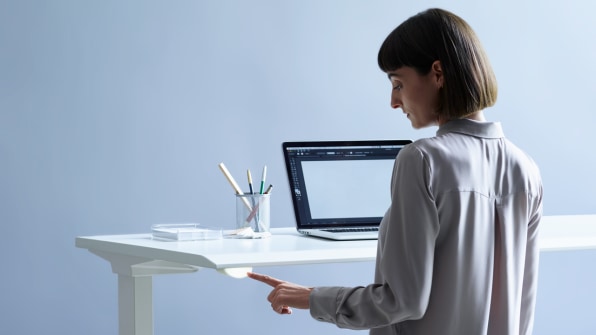Herman Miller Office Chairs Reviews
Imagine that you're sitting at your desk, working on a spreadsheet. That's when you feel a vibration in your hands. Then you see a subtly glowing light. And you realize it's nearly noon, and you've been sitting all morning. So you touch the light. Your desk raises to standing level. And you ditch your chair.
This is the vision of Herman Miller's Live OS. It's a subscription service that links to its new line of sensor-laden tables and chairs and can see how employees are using them. Live OS can do anything from alerting the end user that it's time to stand, to spotting frequently uninhabited desks, to helping a company make its footprint more efficient.

Basically, it's built to please employees at the micro comfort level, and their bosses at the macro organizational level. "The team kept saying human-centered, enterprise-ready," explains Ryan Anderson, director of commercialization and business development at Herman Miller. The project has been in development since 2013, and Herman Miller tapped five design firms to bring various pieces of the project to fruition, including Yves Béhar's Fuseproject. But Anderson stresses that Herman Miller has been thinking about sensors in the workplace for much longer, citing an internal study on wearables from way back in the year 2000.
Seventeen years later, the company is launching Live OS, which mixes a century of furniture industry expertise with a Silicon Valley subscription model, reminiscent of Spotify or Netflix.

Live OS itself is an online platform: Its desks and chairs sync automatically with the cloud, thanks to built-in, encrypted cellular connections. The plans start at $35/month per piece of furniture, escalating to $60/month for full feature sets, with discounts in volume. But the implications for Herman Miller's business are considerable. With roughly $2 billion in revenue made from office furniture, the service could open up tens to hundreds of millions of dollars in new revenue a year–if it's successful.
The Live OS-compatible furniture itself only represents about a $100 premium over unconnected models. These pieces are loaded with sensors; The sit/stand desk, for instance, doesn't just know if it's in low or high position–through infrared sensors, it can see if a person is using it at all. And crucially, it can distinguish a human figure from the chair itself. Herman Miller is also currently developing a version of its famous Aeron chair, fit with capacitive thread that can sense when you sit.
When an employee first gets their furniture, they set up preferences via a smartphone app. Those preferences might include standing goals, in which case the software will send a subtle reminder to stand up through the furniture's ambient vibration and light notifications–both chosen because they'll age gracefully in a corporate setting, compared to something like a touchscreen. The sit/stand desk also features infrared, so it's smart enough to know if you've gotten up for, say, a bathroom or coffee break, even as your desk stays in the seated mode. If so, it might cancel a standing reminder that comes later, so that it doesn't bug you unnecessarily.

It all comes down to the subtlety that Herman Miller is trying to execute: reminders without annoyance. "If someone is in their flow, doing really focused work and want to ignore it, we didn't want to do anything too obtrusive or forcing compliance," says Anderson. Furthermore, as the user gets better about self policing their own standing, the reminders might disappear entirely, only to return if the user gets worse again. In Herman Miller's own testing, it found this notification system created A 6x increase in sitting-to-standing transitions through the day.
Herman Miller believes its connected desks can make corporations healthier, too, by making their space planning more efficient and data-driven. "If we zoom way out, office planning was a lot more predictable when everybody used desktop technology," says Anderson. "For every X desks you use X conference rooms. But with new spaces you see more variety and shared areas, it's very difficult to measure the effectiveness of a space."

If it really can make people healthier at the office, all while cutting waste and streamlining a company's footprint, Herman Miller's subscriptions might be worth it to major institutions with the cash to spend. But is employee privacy the greater hidden cost? Anderson promises that employees can scrub their names from any apps, and that all data is anonymized, but logic would tell you that a particular workplace's specific desk usage data can only be so anonymous. The average IT department can already track internet usage and communications sent by an employee. The frequency and duration of time they spend at their desk–especially as Herman Miller itself admits that employees operate less chained to a single desk than ever before–seems like just the sort of data point that could be leveraged against a worker. An HR department or manager could, theoretically, access a new wave of fuzzy, quantifiable data "proving" why the employee was negligent.
Like all methods of workplace tracking, there will always be tension in how an employee's data is used by their employer. But for now, Live OS is an intriguing product, the ramifications of which are more likely to play out over years rather than months, as early partners sign on. And incidentally, if you've been reading this from your chair, it's probably time to take a break and stand up.
Herman Miller Office Chairs Reviews
Source: https://www.fastcompany.com/90129199/do-you-sit-too-much-herman-millers-new-office-furniture-nudges-you-to-get-up
Posted by: brownsheill.blogspot.com

0 Response to "Herman Miller Office Chairs Reviews"
Post a Comment